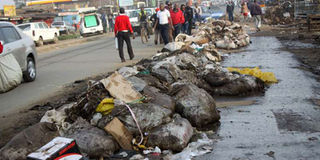Why poor sanitation is costly

People walk near garbage along Naivasha Road in Kawangware, Nairobi on July 6, 2016. PHOTO | ANTHONY OMUYA | NATION MEDIA GROUP
What you need to know:
A clean environment is not just a feel-good social phenomenon; it is an economic issue that has a make or break potential.
Individuals have a great responsibility knowing that they bear a greater economic burden.
Walking down the streets of Kigali, one cannot fail to notice the beauty of this small African city and its cleanliness. It is punctuated by clean roads, manicured lawns, boulevards, and a blue sky. Kenyans assert that even the Rwandese women are more beautiful because of the environment.
Kigali, Rwanda’s capital is host to over 1 million people. At 7 per cent growth of gross domestic product (GDP), it is one of the fastest-growing economies in the region.
Upon his election, President Paul Kagame started a cleanliness programme along the principle of Umuganda, an idea of cohesion similar to Harambee. The programme saw the Rwandese come together every last Saturday of the month to clean their cities and promote national cohesion. Interestingly, there is no stiff legislation on littering, yet Kigali boasts to be the cleanest city in Africa. In October 2008, the city received the Habitat Scroll of Honour award, perhaps the most prized award a city can receive. In addition, the country’s economic growth is partly ascribed to its sanitation.
According to a report tabled in April 2012 by the World Bank, a study on the Economic Impacts of Poor Sanitation in Africa, 18 African countries are losing about USD5.5 billion every year due to poor sanitation. These losses are occasioned by high costs of accessing clean water, premature deaths, healthcare costs, losses in productivity and time lost through the practice of open defecation. The losses are estimated to be about 1 to 2 per cent of the continent’s GDP.
GROWTH TRAJECTORY
Poor sanitation is costly and Rwanda discovered this early hence the steep growth trajectory. Kenya has not discovered the high cost of sanitation.
This week, the country was remembering John Michuki and his efforts to clean Nairobi. Notwithstanding his many other ills, the man did a lot to alleviate the sanitation problems in Nairobi. Nairobi River was cleaned up and the garbage site in Ngara restored. But with him gone, so did the nobility of the idea.
A walk in the streets of Nairobi speaks of indifference among the populace and neglect on the part of the government. The streets are dirty, buildings in disrepair and even the little Kidero grass that remains looks choked! The situation is worse in low income residential areas such as Kayole, Dandora, Mathare, Kibera and Korogocho. Due to the poor planning of buildings and structures in these areas, it is difficult for the county government to manage waste therein. Ironically, the burden of poor sanitation falls disproportionately on the poor.
The problem is not limited to the capital; a spot check in Mombasa reveals dirt, waste and garbage existing side by side with the population. From the smell of Kibarani, the litter of Bondeni, to the neglect of Kongowea and VOK. Mombasa looks like a scene from hell.
WORLD BANK
The narrative rings true in Kisumu, Eldoret, Nakuru and Nyeri – all the major towns in Kenya. And now, the World Bank says this development is slowing down our growth as a nation. In 2012, the country was bleeding about 1 per cent of its GDP due to poor sanitation. More importantly, the loss is more impactful on the GDP per capita.
Put in layman’s terms, GDP per capita of a nation is the share of each individual citizen to a country’s economic produce. By 2015, Kenya’s per capita stood at USD 1,245.
However, the pollution and poor sanitation is causing citizens more than they are willing to pay for. Poor sanitation leads to malaria, typhoid, bacterial infections and respiratory diseases. The cost of treating these diseases is high, whether for an individual or for a family member. Saved, this money could become a big investment.
WATER SOURCES
Additionally, because unchecked garbage destroys water sources, access to clean water has become a challenge. There are about 40 million people living in Kenya, of which about 17 million (43 per cent) do not have access to clean water. Nairobi county government is currently rationing its water, while Nairobi River is running with filth. If it was not contaminated, the river could be a source of water for some. The effect of this is that clean water has become expensive.
Expensive water further translates to high cost of doing business. Industries need water for production and while they are the number one water pollutants, they are also victims as they spend more to access clean water to use in production.
To mitigate these problems and create access to water, the government spends billions of shillings building dams and drilling boreholes; money that could be used in other development activities. Of course this cost is passed on to the populace as more tax.
A clean environment is not just a feel-good social phenomenon; it is an economic issue that has a make-or-break potential on a country. While governments have a role to play in solving the problem, individuals have a greater responsibility knowing that they bear a greater economic burden.
Odhiambo Ramogi is chief executive officer, Elim Capital.
Twitter: @Odhiamboramogi




